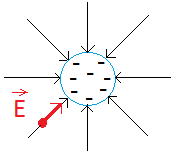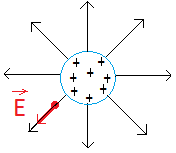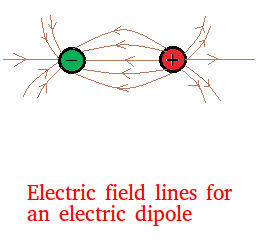Electric field lines
The electric field lines, also called lines of force, give us a nice way to visualize patterns in electric field. Michael Faraday is the one who introduced the idea in the 19th century.
By convention or agreement, to find the direction of the lines, always place a small positive test charge in the electric field.
Again, to find the direction of the lines, don't use a negative charge. Use instead a charge that is positive.
Say for instance you place a positive test charge near a sphere.
Case #1: The positive test charge is placed near a sphere that has a uniform negative charge.
Since opposite charges attract, the charge will be attracted to the sphere.

The electric field lines are shown in black below for more than one
charge. In red we show the electric field vector at the location of the
test charge.

Case #2: The positive test charge is placed near a sphere that has a uniform positive charge.
Since same charges repel, the charge will be repulsed by the sphere.

The electric field lines are shown in black below for more than one
charge. In red we show the electric field vector at the location of the
test charge.

An electric field has both magnitude and direction, so it is a vector.
Each black line is a vector and it represents an electric field line.
You clearly saw what the direction was in the two cases above. What about the magnitude of the field?
The length of the vectors indicates the magnitude of the field.
Electric field lines for an electric dipole
An electric dipole is a system made up of 2 charges with equal magnitude, but opposite sign.

To understand what is going here, you need to envision putting a small positive charge as was done before.
There are 3 situations here to consider:
1.
First, if you consider what is going on between the two charges, the positive charge shown in red in our small positive test charge.
It will be attracted to the small charge shown in green. That is why the arrow is pointing toward the negative charge.
2.
Second, consider what is going on on the left of the negative charge.
Imagine a positive test charge being put there. What will be the result?
It will be attracted to the negative charge. this is shown with the arrows pointing to the negative charge.
3.
Lastly, consider what is happening on the right of the positive charge.
Imagine a positive test charge being put there. What will be the result?
It will be repulsed by the positive charge shown in red. That is why the arrow is pointing in the direction of the positive test charge. It is basically pushing the test charge away.
A real life example of an electric dipole
You can make a capacitor by putting two parallel plates of different sign next to each other as shown in the figure below.

Each plate has more than one of the same charge one on top of the other.